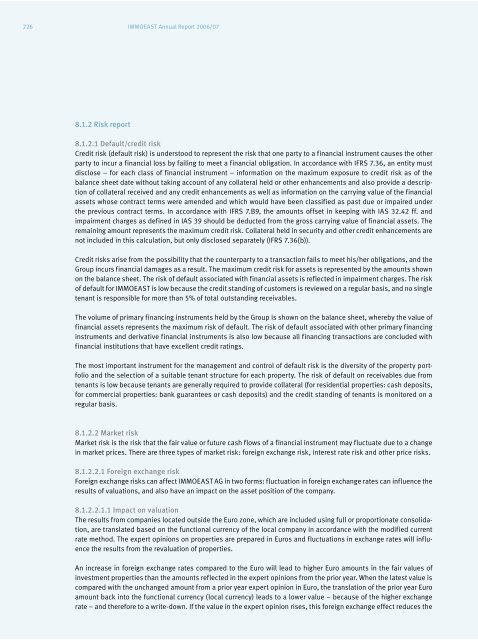IMMOEAST Annual Report 2006/07
IMMOEAST Annual Report 2006/07
IMMOEAST Annual Report 2006/07
Create successful ePaper yourself
Turn your PDF publications into a flip-book with our unique Google optimized e-Paper software.
226 <strong>IMMOEAST</strong> <strong>Annual</strong> <strong>Report</strong> <strong>2006</strong>/<strong>07</strong><br />
8.1.2 Risk report<br />
8.1.2.1 Default/credit risk<br />
Credit risk (default risk) is understood to represent the risk that one party to a financial instrument causes the other<br />
party to incur a financial loss by failing to meet a financial obligation. In accordance with IFRS 7.36, an entity must<br />
disclose – for each class of financial instrument – information on the maximum exposure to credit risk as of the<br />
balance sheet date without taking account of any collateral held or other enhancements and also provide a description<br />
of collateral received and any credit enhancements as well as information on the carrying value of the financial<br />
assets whose contract terms were amended and which would have been classified as past due or impaired under<br />
the previous contract terms. In accordance with IFRS 7.B9, the amounts offset in keeping with IAS 32.42 ff. and<br />
impairment charges as defined in IAS 39 should be deducted from the gross carrying value of financial assets. The<br />
remaining amount represents the maximum credit risk. Collateral held in security and other credit enhancements are<br />
not included in this calculation, but only disclosed separately (IFRS 7.36(b)).<br />
Credit risks arise from the possibility that the counterparty to a transaction fails to meet his/her obligations, and the<br />
Group incurs financial damages as a result. The maximum credit risk for assets is represented by the amounts shown<br />
on the balance sheet. The risk of default associated with financial assets is reflected in impairment charges. The risk<br />
of default for <strong>IMMOEAST</strong> is low because the credit standing of customers is reviewed on a regular basis, and no single<br />
tenant is responsible for more than 5% of total outstanding receivables.<br />
The volume of primary financing instruments held by the Group is shown on the balance sheet, whereby the value of<br />
financial assets represents the maximum risk of default. The risk of default associated with other primary financing<br />
instruments and derivative financial instruments is also low because all financing transactions are concluded with<br />
financial institutions that have excellent credit ratings.<br />
The most important instrument for the management and control of default risk is the diversity of the property portfolio<br />
and the selection of a suitable tenant structure for each property. The risk of default on receivables due from<br />
tenants is low because tenants are generally required to provide collateral (for residential properties: cash deposits,<br />
for commercial properties: bank guarantees or cash deposits) and the credit standing of tenants is monitored on a<br />
regular basis.<br />
8.1.2.2Marketrisk<br />
Market risk is the risk that the fair value or future cash flows of a financial instrument may fluctuate due to a change<br />
in market prices. There are three types of market risk: foreign exchange risk, interest rate risk and other price risks.<br />
8.1.2.2.1 Foreign exchange risk<br />
Foreign exchange risks can affect <strong>IMMOEAST</strong> AG in two forms: fluctuation in foreign exchange rates can influence the<br />
results of valuations, and also have an impact on the asset position of the company.<br />
8.1.2.2.1.1 Impact on valuation<br />
The results from companies located outside the Euro zone, which are included using full or proportionate consolidation,<br />
are translated based on the functional currency of the local company in accordance with the modified current<br />
rate method. The expert opinions on properties are prepared in Euros and fluctuations in exchange rates will influence<br />
the results from the revaluation of properties.<br />
An increase in foreign exchange rates compared to the Euro will lead to higher Euro amounts in the fair values of<br />
investment properties than the amounts reflected in the expert opinions from the prior year. When the latest value is<br />
compared with the unchanged amount from a prior year expert opinion in Euro, the translation of the prior year Euro<br />
amount back into the functional currency (local currency) leads to a lower value – because of the higher exchange<br />
rate – and therefore to a write-down. If the value in the expert opinion rises, this foreign exchange effect reduces the


